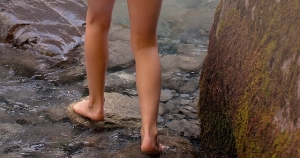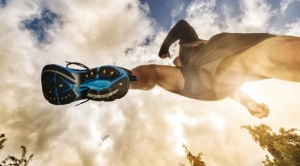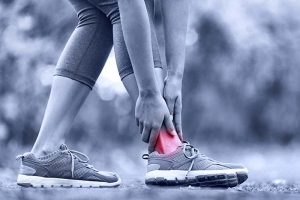Connect With Us
Blogs
Displaying items by tag: Ankle Injury
Avoid Summer Foot Hazards
During the summer months your feet experience some particular challenges. At Superior Foot & Ankle Care Center we want to alert our patients to some potential foot and ankle problems and ways to prevent them.
Puncture Wounds and Cuts—going bare foot increases your risk of stepping on a sharp object. If this does happen and you sustain a puncture wound or cut be sure to clean it out completely and apply an antibiotic ointment and a bandage. Avoid swimming in lakes or the ocean while the wound remains open to prevent an infection from developing. If the area around the wound starts to feel warm or you notice redness or any pus or discharge, contact our Long Beach office immediately by calling: (562) 420-9800. Our podiatrists, Dr. Victoria M. Foley or Dr. Constance Ornelas will examine your foot and determine if you need treatment.
Fungal Infections—athlete’s foot, fungal toenails and warts are among the bacterial and fungal infections that are spread by direct contact. For this reason, we recommend keeping your feet covered in public places like community pools, gym locker rooms and showers and the nail salon.
Heel Pain—if flip-flops are your summer go-to shoes, you may notice an increase in heel pain. The average pair of flip-flops provides no arch support. Flattening of the arch exerts more pressure on your heel. If this is your footwear of choice, invest in a pair designed with sturdy soles and built in arch support.
Ankle Sprains—unfortunately many other summer shoe styles are also lacking in side, ankle and arch support. While these may be fine for dinner out or a special occasion, be sure not to wear them for extended periods of walking or sports activities as this likely to result in an ankle twisting injury.
Fortunately, a little common sense and smart choices can go a long way toward protecting your feet this summer. If you have foot pain or discomfort, don’t hesitate to contact us for an appointment.
5 Foot Friendly Vacation Tips
At Superior Foot & Ankle Care Center we’ve heard horror stories of summer vacations that patients never got to enjoy because they were sidelined by a foot problem early on in their trip. We’d like to help prevent podiatric mishaps when traveling and so we are offering these 4 tips for safer summer vacations:
- Wear comfy shoes on travel days. Whether you’re flying or taking a long road trip, you’ll want to start (and end) your trip with a comfortable pair of shoes, preferably ones with low heels and roomy toe boxes. Travel days can be strenuous—loading luggage, running to catch a flight, getting in and out of the car, are all best done in a pair of shoes that won’t hurt your feet or cause you to trip or fall. You will also want dependable shoes for walking and sports activities—save the heels and sandals for dinner out.
- Wear water shoes at the beach or lake. If there’s water in your vacation plans be sure to pack water shoes. Rocks, nails, glass, broken shells and washed up jellyfish and insects can be hidden in sand and mud and you can protect your feet from puncture wounds, cuts and stings by keeping them covered. Another good reason for water shoes (and this is true at a resort pool too) is that they prevent your feet from coming in contact with fungi and bacteria that lurk in warm, moist, public places. Nobody wants to bring home a case of athlete’s foot!
- Lather on the sunscreen. If the sun can get to your feet, your feet can end up sunburned. Badly burned feet can mean spending precious vacation days unable to walk. Apply sunscreen to the tops and bottoms of your feet when at the beach or pool. For sightseeing or shopping trips, if you’ll be wearing sandals put sunscreen on first, then your shoes.
- Drink lots of water. Edema, or swelling of the feet and ankles, can make walking painful. Staying hydrated helps to get rid of excess fluid and decreases swelling. Plus, it’s good for the rest of your body too!
- Add a few items to your pack list. They won’t take up much space but moleskin, some bandages and antibiotic ointment, extra socks and foot powder can make your days more comfortable.
If your summer vacation leaves you with any unwanted souvenirs such as an ankle injury, an unexplained rash or foot pain, contact our Long Beach office as soon as you return by calling: (562) 420-9800. Our podiatrists, Dr. Victoria Foley or Dr. Constance Omelas will help determine the cause of the problem and prescribe the right treatment to get you back to basking in the afterglow of your vacation.
Choosing the Right Running Shoes | Superior Foot and Ankle Care Center
How to Choose the Best Running Shoe for You
Whether you’re a running novice or an experienced veteran, picking out running shoes can be a daunting task. It can be tempting to just grab the best looking pair from a popular brand, but the right shoes are imperative in preventing running-related injuries. With so many options bragging a variety of different features and claiming to help with an assortment of problems, it’s hard to know which shoes are right for you. Fortunately, there are a number of things you can keep in mind to help you make the right decision.
Shoe Buying Myths
To start, there are a number of myths surrounding running shoes. It’s important to not buy into them in order to find the best shoe for you.
There’s a Best Running Shoe
Many people choose a running shoe based on the popularity of a brand or shoe style, but everyone’s foot, running style, and needs are different. There’s no running shoe that is best for all, or even most, people. That’s why there are so many options available.
I’ve Found a Shoe I Like, so I Don’t Need to Try on Shoes Again
The same model of shoe won’t work for you forever. Models change slightly or even dramatically between years, as do your needs. Your running form can change over time due to injuries or strengthening and weakening muscles. Changes in your goals, routine, or running surface can also affect your needs. There’s also evidence that shows that alternating between different models from workout to workout can help to strengthen your ankle and foot.
The Right Shoe Will Help My Times
Your shoe won’t make you faster, but it can make you feel faster as your gait becomes more comfortable and natural. However, wear in the sole can slow you down and make you more prone to trips or falls as the shoes lose their grip. To prevent this, shoes should be replaced every 300 to 400 miles to prevent injury and ensure comfort.
Your Individual Needs
When shopping for running shoes, it’s helpful to determine your specific needs based on both the shape and size of your foot and your running style. Whenever you try on shoes, remember to bring any braces or inserts you need.
Shoe Size
When buying shoes, remember that size varies between brands and even between models within the same brand. The size you’ve worn in other shoes provide an estimate of the side you need, not a guarantee. Try on several different sizes to see what you like best. Laces should be snug and the ankle shouldn’t rub. You should have about a thumbnail’s space between your toe and the end of the box. (‘Barefoot’ style shoes are an exception. They should fit close to the toes, ‘like a glove.’) It’s helpful to try on shoes at the end of the day when they’ve swelled and are at their largest.
You should also remember that you don’t have to stick to the shoes in your gender’s section. Men with narrow feet may have luck with a women’s shoe while women with broad feet may have better luck with with a man’s shoe.
Arch Height
Like in any other shoes, having the proper support for your arch height in running shoes is important for ensuring comfort. Many running stores can help you determine your arch height, but you can also get some idea of your arch height at home using the ‘wet’ test.
Strike Location
When you foot hits the ground, it should land ankle first for the best possible form, but many people’s feet land farther forward on the foot. This can be corrected by the drop of the shoe, or the difference between the height of the toe and the height of the ankle of the shoe. A higher drop forces the foot to plant farther back.
Pronation
Pronation refers to the inward roll of the foot after the foot strikes the ground. Virtually everyone has some pronation, but there are shoes to stabilize over or under-pronation. For those who don’t need correction, minimalist or ‘barefoot’ shoes are options.
Superior Foot and Ankle Care Center
All of this information certainly provides guidance when shopping for running shoes, but what’s most important is that you find shoes that you like and makes you comfortable. If you overpronate but aren’t comfortable in any of the shoes for overpronation, not only will you be less likely to run, you may be more likely to hurt yourself, according to a 2015 study.
While finding the right shoes can be difficult, they are imperative to staying healthy while pursuing your running goals without injury. If you have difficulty finding the right pair, or suffer from a foot or ankle injury that makes running difficulty, the experts at Superior Foot and Ankle Care Center in Long Beach, California can provide you with the care and support you need to meet your goals. Contact us today to schedule an appointment and join our many satisfied customers.
Making Sure Your Ankle Heals Properly After Injury
If you have sustained a sprain or a fracture to your ankle, it is important to let it heal properly in order to avoid permanent damage. Ankle sprains are incredibly common: over 25,000 people suffer them every day. A sprain occurs when one or more ligaments on the outside of your ankle are pulled or torn. As it is hard to differentiate a sprain from a fracture, it is imperative to seek medical attention so that your ankle can be x-rayed. Once your injury has been diagnosed, you’ll be able to give it the care it needs in order for it to heal properly. Here are some tips for properly caring for your ankle injury to ensure that it heals correctly:
For a Sprain
Depending upon how serious the sprain is, the sprain can be classified as grade 1, 2, or 3. The best way to treat a sprain is to utilize the R.I.C.E. method: rest, ice, compression, and elevation. For a grade 1 sprain, you should rest your ankle by not walking on it as much as possible, only putting minimal weight on it. In many cases, an ankle brace will be given in order to help reduce the swelling and discomfort of a sprain, which may make it easier to put some weight on it if need be. However, if it is too difficult to bear weight, you may be given crutches. You can apply ice to help relieve the pain and swelling. When you ice your ankle, make sure that there is a barrier between the ice and your skin, such as a pillowcase or a towel. You shouldn’t ice your ankle for more than 20 minutes in order to avoid frostbite. Compression can help control the swelling, as well as provide your ankle with some support. Finally, you should elevate your ankle as much as possible by reclining and propping it up. It’s best to elevate your ankle either above your waist or your heart for optimal recovery.
With a grade 2 sprain, you would follow the same steps. While the grade 1 may take a week to heal, a grade 2 may take up to a month. Grade 3 sprains are rare and may require casting or surgery.
For a Fracture
If you fracture your ankle, your treatment will involve casting, taping, wrapping, or booting, depending upon the type and severity of the fracture. Much like a sprain, it is important to rest and elevate a fractured ankle. A fracture usually takes 4 to 8 weeks to heal. Once the cast comes off, you may have to follow the R.I.C.E. method until you regain strength in your ankle.
Rehabilitating Your Ankle
If you have a sprained or fractured ankle, you need to properly rehabilitate it in order to regain your full strength and flexibility. The first phase of rehabilitation is the R.I.C.E. method. The second phase is helping your ankle regain flexibility, strength, and range of motion by walking and putting weight on it. The last phase is exercising your ankle in order to strengthen the muscles and ligaments further.
Be sure to follow these steps to help your ankle heal properly. If you have any questions or concerns about your ankle injury, contact us today to schedule an appointment.




